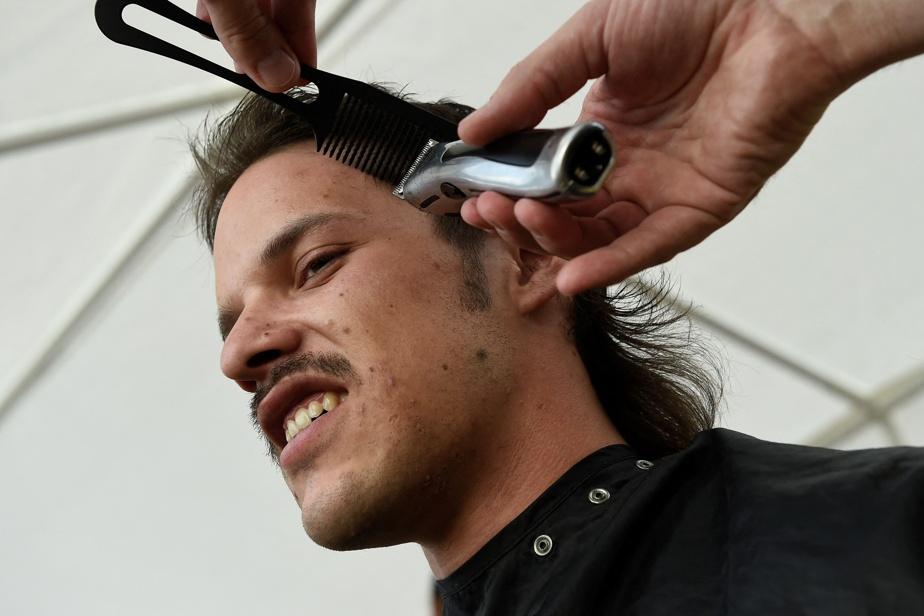The relentless return of the “Longueuil” cup
(Paris) Short in front, long in back: popular in the 1980s, before being considered a crime against elegance, the mullet cut is making its unlikely comeback.
Published on March 5, 2021 Eric RANDOLPH Agence France-PresseWith singers like Rihanna and Miley Cyrus, but also a surprising number of English rugby internationals, this hair style has reinvested television screens and chic arteries around the world.
"My idols have always been David Bowie and Princess Diana, so the initial idea was to look like the child they could have had together," says Sharon Daniels, a 26-year-old Australian from Brighton (south of England).
“Shaz” (her nickname) was way ahead of fashion, and when she landed in this seaside resort, there was only one other inhabitant with the same haircut. She knew it: people were sending her pictures of this man.
Today, the mule is everywhere. “I'm not necessarily happy about it, since now it seems that I'm trying to blend in,” jokes Sharon Daniels. " It does not bother me. I know how long I've been wearing it."
"Completely assume"
The cycles of fashions are as inexorable as the rotation of the Earth, but this vogue, many believed it was buried for good.
"She's come back from the dead," said Tony Copeland of the British Master Barbers Alliance. For him, confinement was a factor: people were able to try at home without being afraid of immediate reactions. “We are going to see more and more this year. The guys are fed up with all the downgrades.

The competition should make undecided the result of the competition of the Mule Cup Festival, a European event whose last edition took place near Mons, in Belgium, in May 2019.
The defending champion, Frenchman Gauthier Istin, a Breton farmer, is confident in his chances of regaining titles. He even plans to walk to the French version of the festival that a group is trying to mount in the Creuse department (southwest), in June 2021.
“I would like to do talks, meet like-minded associations of different thinking, do fun things in hair salons and invite people to walk together… With a mule as much as possible,” he explains to the AFP. For him, it's a whole philosophy, “self-affirmation”. “You have to have self-confidence to discredit yourself a little in the eyes of others and take it on completely”.
“Simplicity and Innocence”
He would like to remind you that this cut dates back to well before the 1980s, also the era of jackets with large shoulder pads and rolled up sleeves. "It's interesting to see that in ancient frescoes, Roman mosaics, people wore the mullet because it's much simpler than any other hairstyle."
According to the History Channel, the first mention in literature dates back to Homer's The Illiad, where warriors are described with "bangs, and long hair at the back."
Moreover, the cut of the American revolutionary Benjamin Franklin, bald on the top of the head, long behind, was considered an asset in convincing the French to support the cause of the United States, at a time when he was ambassador in Paris. It would have meant "simplicity and innocence" in the days of dressed up wigs.
Yet this hairstyle has long had no name. She was only baptized in 1994 thanks to a song by American rappers Beastie Boys, Mullethead.
“No sunburn”
At that time, she dragged a bad reputation. The vulgar cut of the prolo, fan of tuning in the north of France, or of the marginal who lives with a naughty dog in a caravan in a lost hole in the south of the United States.
“It really became a foil in the 90s,” describes Deirdre Novella, hairdresser in New York. "It was for people who lived deep in the woods with no idea what was going on."
According to some theories, the cup had a practical function: to protect the back of the neck from the sun, while requiring little maintenance or skill with the scissors.
“It's true that I don't have a sunburn on the back, and I don't have to tie my hair up when I use a circular saw,” notes Sharon Daniels.
But customers who ask for it at Deirdre Novella in her Brooklyn neighborhood have other concerns on their minds. They are often from the LGBT, or “hardcore” artistic community.
“You need a really radical style: the type of people who wear clothes that don't look good, but are so fashionable that they don't like it,” says the hairdresser.








